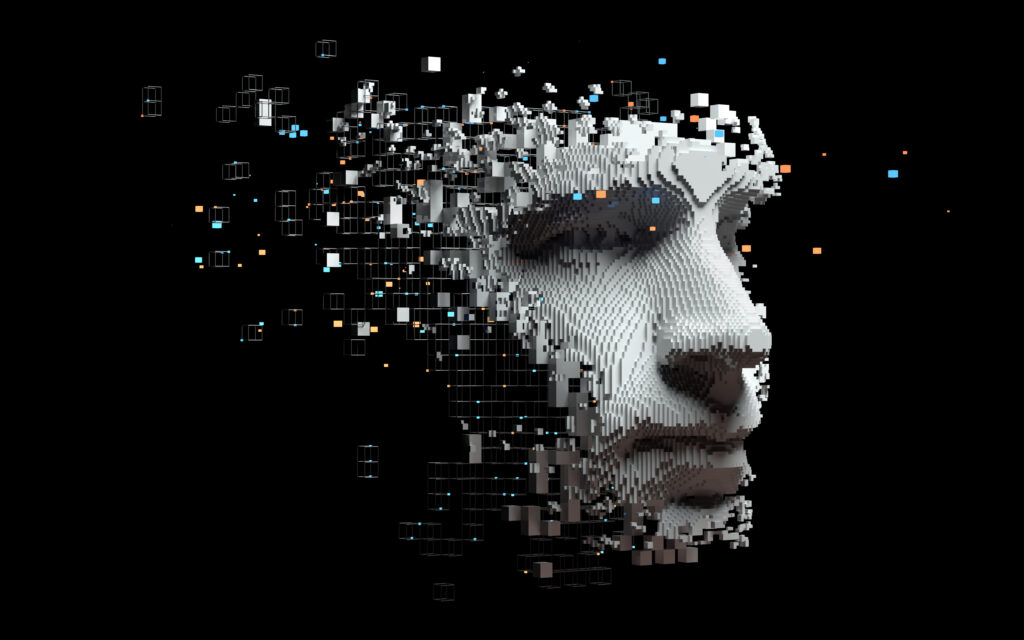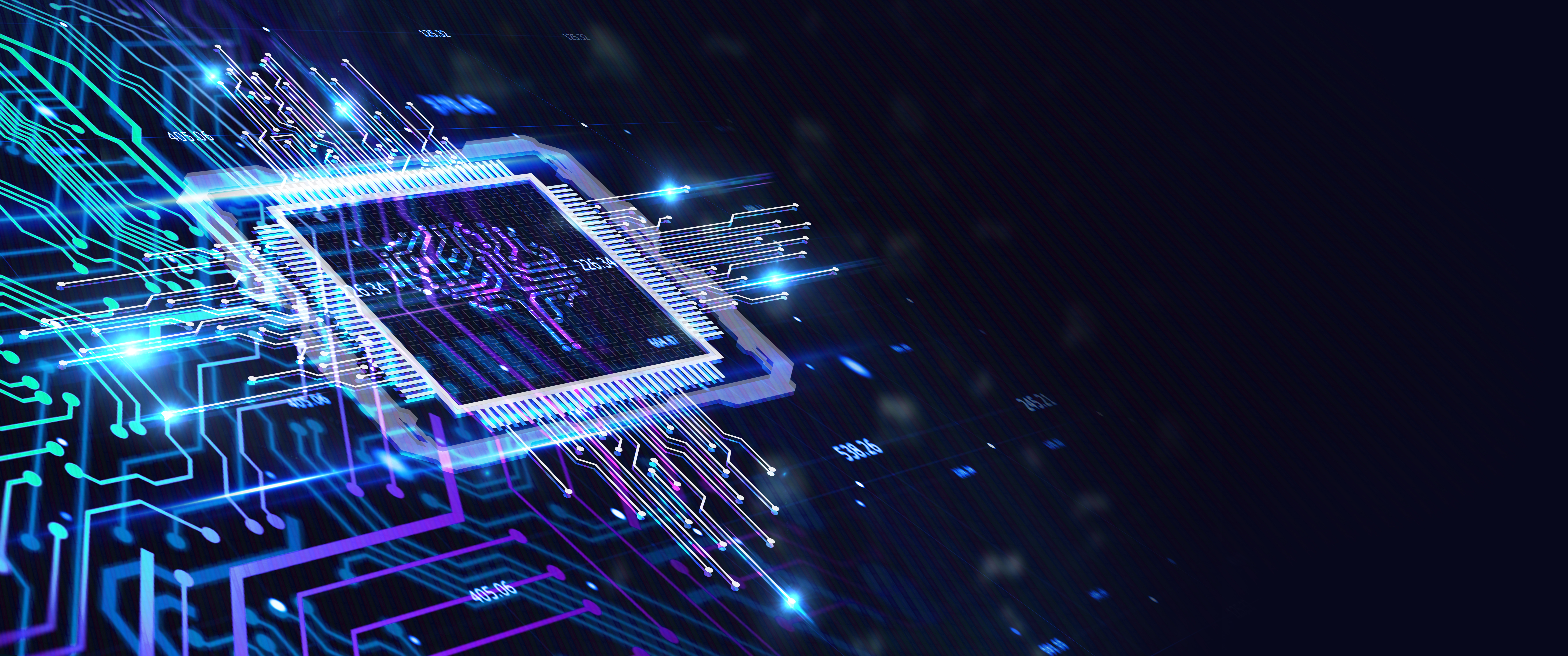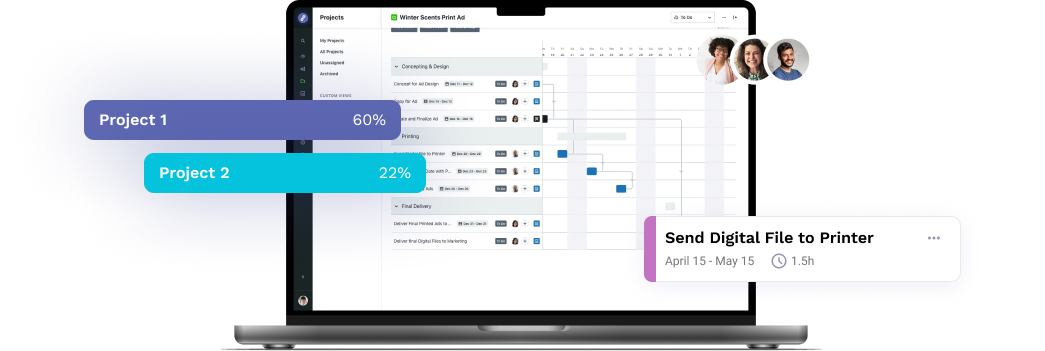
We’re taking a journey into the artificial intelligence universe to discover how it brings about positive transformation in business and change in creative professions. AI is not just the latest trend in tech — it’s the cool, futuristic magic that’s turning creative industries upside down. It’s like that tech-savvy friend who always has the latest gadgets and knows all the best shortcuts in software form.
What Exactly Is Artificial Intelligence (AI)?
AI is “the science and engineering of making intelligent machines, especially intelligent computer programs. It is related to the similar task of using computers to understand human intelligence, but AI does not have to confine itself to methods that are biologically observable,” wrote John McCarthy, who is part of the Computer Science Department at Standford University.
In other words, you can imagine AI as an intelligent robot that can do some seriously smart stuff. It’s like having a personal assistant who can understand you without speaking any human language. AI is all about making machines super clever, and it’s changing the game in creative industries!
How Does AI Work? What Methods Are Used to Train It?
AI isn’t just sitting around twiddling its robotic thumbs. It learns by mixing advanced algorithms and enormous amounts of data to evolve and get smarter every day. It is now used in most industries and its wide application reaches audiences larger than those that attended Beyonce’s Renaissance Tour – can you believe it? Here is an overview of the components and methods that make AI great:
Machine Learning
Machine learning techniques are the toddler-like part of AI systems in that they figure things out on their own without being explicitly told to do so. It uses methods from neural networks, statistics, operations research, and physics.
Neural Networks
Neural networks engage in rigid and repetitive A/B testing of data sets. They consist of interconnected units (neurons) that process information by responding to external inputs and relaying information between each unit. They require multiple passes at the data to find connections and derive meaning from undefined data.
Deep Learning
AI goes deep by employing large neural networks with multiple layers of processing units. It uses computing power and training techniques to learn complex patterns in extensive datasets. It is commonly applied in image and speech recognition with mixed results.
Computer Vision
Like you do at your optometrist appointment, AI systems can recognize and interpret images and videos instantly by relying on pattern recognition and deep learning techniques to understand what is presented to them.
Natural Language Processing
NLP helps computers analyze and generate human language, including speech and singing. This has already given rise to a new category of AI covers of popular songs on YouTube. NLP also includes natural language interaction, allowing humans to communicate with computers using everyday language to perform tasks.
Graphical Processing Units
GPUs are the supercomputer part of AI, used especially for training neural networks with large datasets. It’s like offering access to a super-speed computer to your already-supercharged AI software.
Internet of Things
AI is a data wizard. It automates models to analyze heaps of data, making it possible to use more of it for various applications.
Advanced Algorithms
AI employs advanced algorithms that are continuously developed and combined in innovative ways to analyze data faster and at multiple levels. This intelligent processing is essential for identifying and predicting rare events, understanding complex systems, and perfecting unique scenarios. Despite this description, very little is known about how advanced algorithms work, even by those who build them!
APIs (Application Programming Interfaces)
APIs are AI’s way of passing the torch of knowledge to make everything smarter and cooler. They enable the integration of AI capabilities into various applications, such as image recognition in home security systems or data analysis.

What Purposes Is AI Used For?
AI’s capabilities are reshaping how businesses run and make critical decisions. Here is why businesses have been so keen to invest heavily in AI in recent months:
It Reduces Human Error
AI can significantly reduce human error by making predictions and decisions based on real-time data. This helps in making informed choices and avoiding mistakes – except for when human features are involved.
Helps with Research and Data Analysis
AI turbocharges research and data crunching, reducing the time it takes for tasks that would typically require months of human effort.
Offers (Questionably) Unbiased Decision-Making
AI, when fed with unbiased and correct data, can make unbiased decisions and predictions. It helps end human favoritism and prejudices in decision-making. Of course, we have yet to reach a point of feeding our AI tools with completely unbiased information.
Automates Repetitive (a.k.a. Boring) Tasks
AI is excellent for automating repetitive tasks, freeing up human resources to focus on more complex and valuable tasks. You can think of AI in this instance as that friend who loves doing the dishes after dinner.
It Aids in Forecasting Sales
AI can predict sales trends and outcomes by analyzing historical and real-time data, allowing businesses to make informed decisions and perfect sales strategies.
Helps You Create Targeted Advertisements and Personalized Content
AI knows you better than you know yourself. It tailors ads and content just for you, making marketing more personalized than ever before.
Generates Leads
AI streamlines lead generation processes by collecting customer data, creating profiles, and generating contact lists of potential customers likely to convert, saving time and improving lead quality.
Regulates Dynamic Pricing
AI helps businesses implement dynamic pricing strategies by analyzing supply, demand, and customer behavior to adjust prices for products or services. This is why some concert tickets cost an arm and a leg these days.
AI in Creative Industries: The Revolution is Real!
AI isn’t just some futuristic fantasy; it’s a real game-changer in creative fields. It’s not here to replace us; it’s here to jazz things up (allegedly). These are the industries where AI is currently making waves:
Graphic Design: Creating logos, branding materials, and digital artwork.
Music Composition: Composing original music, generating melodies, mimicking music.
Film and Video Production: Video editing enhancement, visual effects improvement, and animation creation.
Fashion Design: Predicting fashion trends, creating clothing patterns, and generating fashion sketches.
Content Creation: Generating AI text, articles, and blog posts.
Advertising and Marketing: Improving ad campaigns and generating ad copy and visuals.
Architecture and Design: Enhancing building designs and floor plans and materials needed.
Writing and Literature: Creating poems, stories, and novels. Offers grammar and style suggestions.
Gaming and Game Design: Enhancing the gaming experience with procedural content generation and AI-generated characters.
Visual Arts and Illustration: Generating digital art, illustrations, and concept art.
Culinary Arts: Aiding chefs in developing new recipes and perfecting ingredient combinations. AI-driven kitchen robots automate food preparation and cooking.
Creative Agencies: Streamlining creative processes, from idea generation to campaign execution.
Photography: Adjusting lighting, color balance, and composition in photos.
How Does AI Shake Things Up in Different Creative Professions? What’s in It for Us?
Apart from redefining the look of human hands (age is a joke), ears (Dragon Ball Z villains, anyone?) and fingers (we love a 7-fingered hand) forever, AI comes with its fair share of unpredictability, as do most new tools. While AI is still a long way from perfectly copying human creativity, it is already transforming the creative world in several, sometimes unexpected, ways:
Helping in the Creative Process
AI can be a creative’s sidekick during the creative process, helping with generating ideas or even entire pieces of literary work.
Generative Art
AI-generated art, known as generative art, has made considerable progress, and has even won awards at art events. This type of art is created by computer programs rather than human artists. Imagine a computer program creating jaw-dropping artwork that even Picasso would envy. It’s a bit like having an art prodigy at your fingertips.
Music Creation
Apart from being an accomplished painter, AI has also ventured into music creation, producing music in several styles and genres, and even mimicking the voices of famous singers. This genre of AI-generated music, known as Deepfake music, can be so convincing that it is challenging to distinguish from human-created music.
Doing the Boring Tasks for You
AI isn’t content with just being creative; it’s here to lend a hand with the boring stuff too. Picture this: AI handling all the repetitive tasks like photo editing or video tweaking while you focus on the exciting, creative parts of your work.
Data Analysis and Insights
AI can analyze data to reveal insights into customer behavior and market trends. This data analysis can be valuable for product development and marketing campaign decisions. It may just be the intermediary that data and creatives have needed since the advent of digital marketing!
Film and Movie Creation (Lights, Camera, AI-ction!)
AI technology has been used to generate scripts for short films, paving the way for potential AI-created films and movies in the future. While AI may not replace human creativity entirely, it can offer new avenues for filmmakers and artists to explore.
What Are the Side-Effects of the Widespread Use of AI?
The widespread use of AI in creative roles has brought about many benefits but also raised certain side-effects and challenges:
Shift in Assumptions
Until recently, we assumed that creative jobs would be safe from automation. Not anymore. Thanks, technology!
Loss of Originality
AI-made content can sometimes feel a bit like mass-produced, missing that unique human touch.
Unemployment Concerns
With AI taking over creative tasks, some folks are worried about job security in the creative industries.
Ethical and Legal Issues
AI-generated content can raise some sticky ethical questions, especially when it comes to ownership and copyright.
Quality Control
Relying too heavily on AI without quality control can lead to less-than-stellar results. We don’t want our creativity to take a hit!
Dependency on Technology
Creatives might start leaning on AI so much that they forget their own creative superpowers.
Privacy Concerns
With AI collecting and analyzing user data for personalization, privacy concerns are on the rise.
Bias and Fairness
AI can inherit biases from its training data, leading to biased content and decisions.
Loss of Human Connection
AI-powered chatbots and virtual influencers might replace genuine human interaction. Say goodbye to heartfelt connections?
Artistic Skill Slumber Party
Artists might get so comfortable with AI doing everything that they forget to sharpen their own creative skills.
Economic Disparities
Smaller creative businesses could struggle to compete with the big guys who have deep pockets for AI tech.
Stereotyping Central
AI algorithms might reinforce stereotypes in creative content by sticking to existing patterns.
Aesthetic Homogenization
AI-generated content could become a sea of sameness, drowning out diversity and innovation.
Depersonalization of Art
AI-made art and music might miss that deep emotional connection that only humans can bring.
Resistance to Change
Some creatives might resist AI, fearing it’ll steal their creative thunder or destroy traditional artistic processes.
With All This in Mind, Should You Consider Using AI-Powered Tools?
AI has crushed the creative scene automating tasks, crunching data, and even dipping its toes into scriptwriting. It challenges the assumption that creative jobs are immune to automation, making us question the future of creative professions. Nevertheless, experts insist that AI will only bring more opportunities for creative professionals.
However, this AI invasion isn’t all roses. There’s a risk that creative work might become unoriginal, with ethical dilemmas and tech over-dependency lurking in the shadows. To navigate this successfully, we need to strike a balance between embracing AI’s potential and preserving the essence of creativity.
We at Lytho help you streamline your entire workflow and harmonize all brand collateral under a single, uniform platform. Schedule a demo and learn how our creative solutions can boost the effectiveness of your creative projects.
Do you want to give yourself and your creative team more room for creative stimulation by automating the boring stuff? Lytho helps you streamline your entire workflow and harmonize all brand collateral under a single, uniform platform. Feel free to reach out to us by scheduling a demo and learning how our creative solutions can boost the effectiveness of your creative projects. We look forward to speaking with you!

Ready to simplify your creative operations and start having a little fun at work again? Schedule time to talk with us.
Let us show you how Lytho’s Creative Operations Platform helps in-house creative and marketing teams do better work, ease the stakeholder experience, and stay on brand.
Schedule a Demo